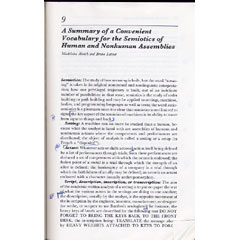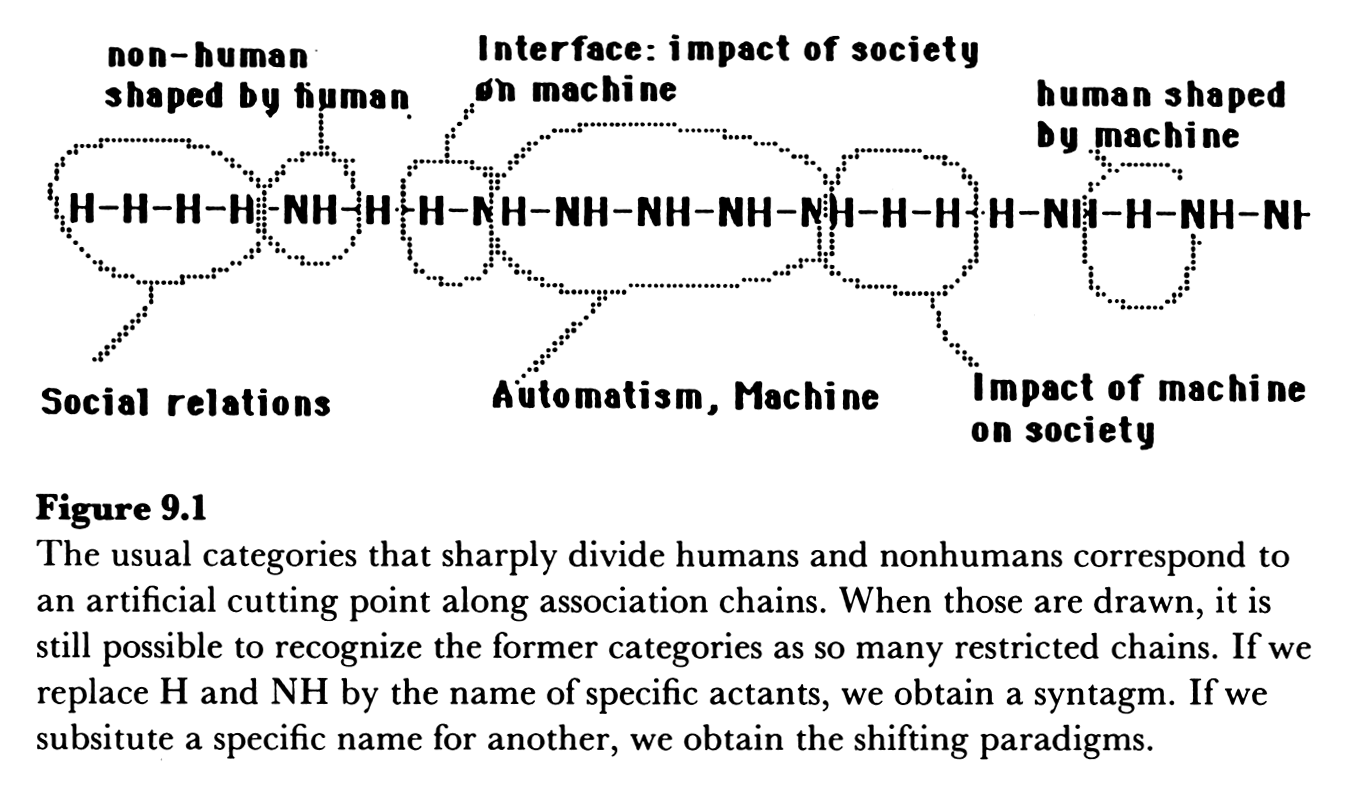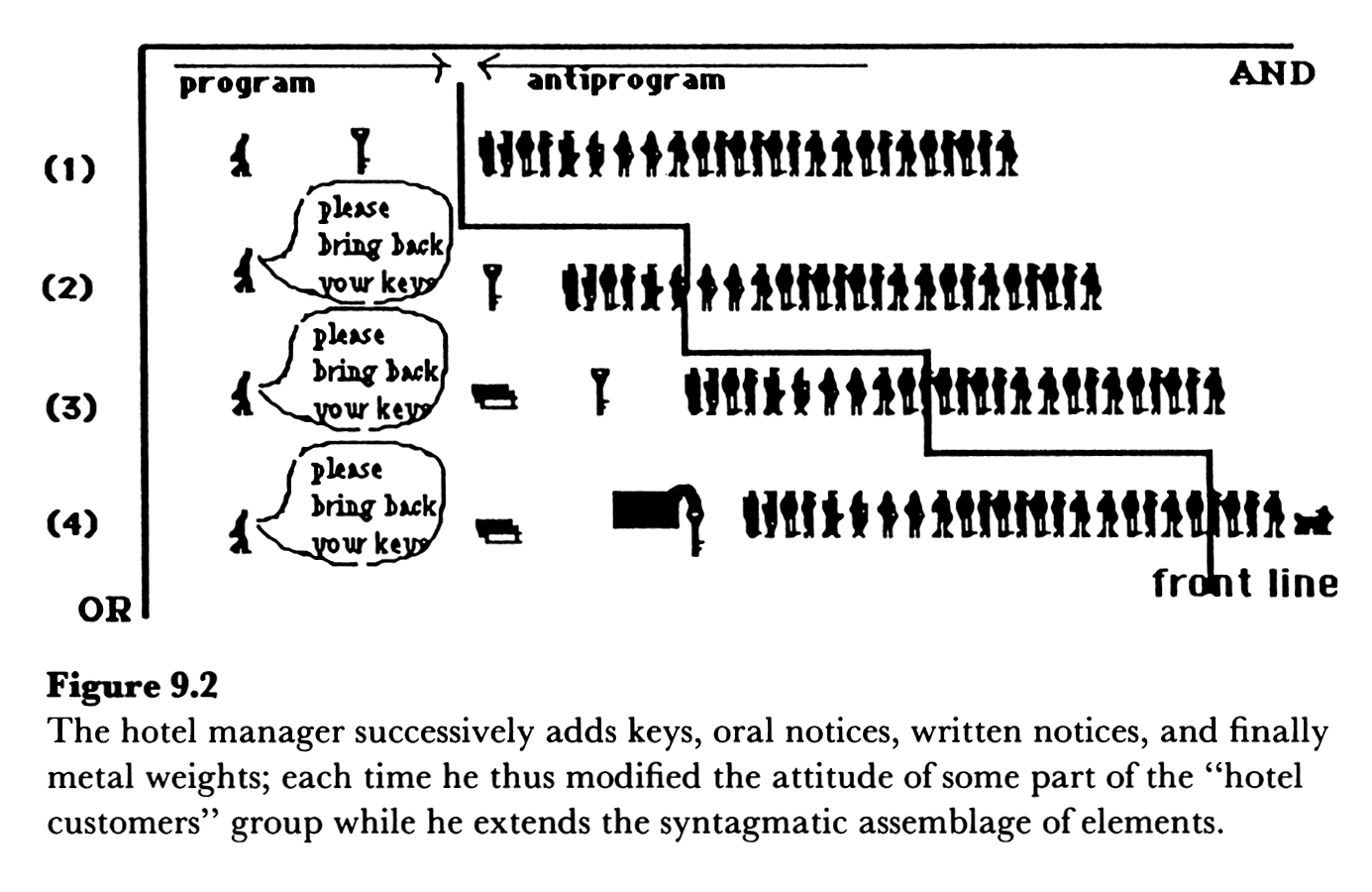
NOTE: This essay is Chapter 9 (pages 259-264) of Bijker & Law (1992) - Shaping Technology / Building Society: Studies in Sociotechnical Change
[259] {setting, context, dispositif, definition} Setting: ...(in French a "dispositif").
[259] {actant, actor, actions, definition} Actant: Whatever acts or shifts actions...
[259] {script, description, de-scription, inscription, in-scription, transcription, definition} ...the de-scription, usually by the analyst, is the opposite movement of the in-scription by the engineer, inventor, manufacturer, or designer (or scribe, or scripter to use Barthes's neologism)...
[260] {shifting, frame, frame of reference, actant, actor, ego, definition} Shifting out, shifting in: Any displacement to another frame of reference that allows an actant to leave the ego. hic. nunc -- shifting out -- or to come back to the departure point -- shifting in.
[260] {program, action, program of actions, definition} Program of actions: This term is a generalization of the narrative program used to describe texts, but with this crucial difference that any part of the action may be shifted to different matters...
[261] {antiprograms, antiprogram, program, definition} Antiprograms: All the programs of actions of actants that are in conflict with the programs chosen as the point of departure of the analysis; what is a program and what is an antiprogram is relative to the chosen observer.
[261] {prescription, proscription, affordances, affordance, allowance, allowances, definition} Prescription; proscription; affordances, allowances: What a device allows or forbids from the actors -- humans and nonhuman -- that it anticipates; it is the morality of a setting both negative (what it prescribes) and positive (what it permits).
[261] {subscription, de-inscription, deinscription, definition} Subscription or the opposite, de-inscription: The reaction of the anticipated actants -- humans or nonhumans -- to what is prescribed or proscribed to them...
[261] {pre-inscription, preinscription, actor, crisis, subscription, definition} Pre-inscription: The competences that can be expected from actors before arriving at the setting that are necessary for the resolution of the crisis between prescription and subscription.
[261] {circumscription, pre-inscription, preinscription, setting, definition} Circumscription: The limits that the setting inscribes in itself between what it can cope with -- the arena of the setting -- and what it gives up, leaving it to the preinscription.
[261] {conscription, pre-inscription, preinscription, setting, definition} ...conscription is the series of actors that have to be aligned for a setting to be kept in existence or that have to be aligned to prevent others from invading the setting and interrupting its existence; it is what makes the pre-inscription more favorable for a setting...
[261-262] {interface, plug, plugs, preinscription, circumscription, definition} Interface or plugs: The many gaps between preinscription, circumscription, and conscription are tentatively limited by plugs, sieves, "decompression chambers," or more generally interfaces...
[262] {re-inscription, reinscription, definition, inscription, feedback, program, antiprogram, setting, preinscription} Re-inscription:: The same thing as inscription but seen as a movement, as a feedback mechanism; it is the redistribution of all the other variables in order for a setting to cope with the contradictory demands of many antiprograms; it usually means a complication -- a folding -- or a sophistication of the setting; or else it means that the complication, the sophistication is shifted away into the pre-inscription; the choices made for the re-inscription defines the drama, the suspense, the emplotment of a setting.
[262] {human, nonhuman, redistribution, network, competence, performance, setting} Redistributing competences and performances of actors in a setting: The new point fo departure for observation instead of the divide between the humans and nonhumans; the directions fo this redistribution are many: extrasomatic, intrasomatic, soft-wire, hard-wire; figurative, nonfigurative; linguistic, pragmatic...
[262] {ascription, definition, setting} Ascription: The attribution process through which the origin of the activity of the setting is finally decided in the setting itself...
[262-263] {scribe, enscriber, scripter, designer, author, definition} Scribe, enscriber, scripter, designer, or author: Who or what is the designer of a setting is the result of a process of ascription or attribution...
[263] {AND, syntagmatic, syntagm, association, alliances, OR, paradigmatic, paradigm, substitution, translation, definition, reinscription, setting, history, program, antiprogram, plot, script} AND (syntagmatic, association, alliances); OR (paradigmatic, substitution, translation): The two fundamental dimensions for following the reinscription of a setting, hence its dynamic or history... the front line between programs and antiprograms maps out the plot of a script and keeps track of its history.


